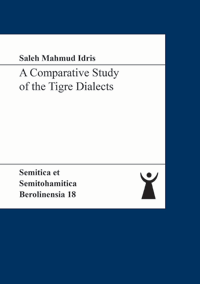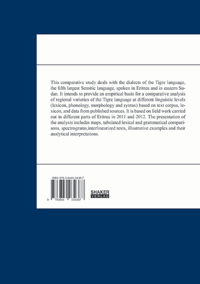
Shop : Details
Shop
Details
49,80 €ISBN 978-3-8440-3438-7Softcover276 pages405 g21 x 14,8 cmEnglishThesis
March 2015
Saleh Mahmud Idris
A Comparative Study of the Tigre Dialects
This comparative study deals with the dialects of the Tigre, the fifth largest Semitic language, spoken in Eritrea and in eastern parts of the Sudan. It intends to provide an empirical basis for a comparative analysis of regional varieties of the Tigre language at different linguistic levels (lexicon, phonology,morphology and syntax) based on text corpus, lexicon, and data from published sources. It is based on field work carried out in different parts of Eritrea in 2011 and 2012. The presentation of the analysis includes maps, tabulated lexical and grammatical comparisons, spectrograms, interlinearized texts, illustrative examples and their analytical interpretations.
In a summary, the most decisive lexical, phonological and morphological isoglosses divide the Tigre dialects into three major dialect blocks, i.e. the north-western dialects of Ḥabāb, ʿAd-Tekles, Mārya Qayaḥ, Mārya Ṣallām, Beni-ʿĀmər, and the south-eastern dialects of Zula and Massawa, Gəndaʿ, Masḥalit, and a third block in the centre of the Tigre land which contains the dialects of Mansaʿ and Bet-Ǧuk. Səḥe and Dərfo change affiliation from one block to the other depending on the tribal background of the people included in the sample. ʾAlgaden most often affiliates with the first blockwith certain peculiarities of its own. Dahālək is the most divergent variety and it deserves to be treated separately.
In a summary, the most decisive lexical, phonological and morphological isoglosses divide the Tigre dialects into three major dialect blocks, i.e. the north-western dialects of Ḥabāb, ʿAd-Tekles, Mārya Qayaḥ, Mārya Ṣallām, Beni-ʿĀmər, and the south-eastern dialects of Zula and Massawa, Gəndaʿ, Masḥalit, and a third block in the centre of the Tigre land which contains the dialects of Mansaʿ and Bet-Ǧuk. Səḥe and Dərfo change affiliation from one block to the other depending on the tribal background of the people included in the sample. ʾAlgaden most often affiliates with the first blockwith certain peculiarities of its own. Dahālək is the most divergent variety and it deserves to be treated separately.
Keywords: Dialectology; Linguistics; Ethio-Semitic languages; Eritrea
Export of bibliographic data
Shaker Verlag GmbH
Am Langen Graben 15a
52353 Düren
Germany
Am Langen Graben 15a
52353 Düren
Germany
Mon. - Thurs. 8:00 a.m. to 4:00 p.m.
Fri. 8:00 a.m. to 3:00 p.m.
Fri. 8:00 a.m. to 3:00 p.m.
Contact us. We will be happy to help you.



